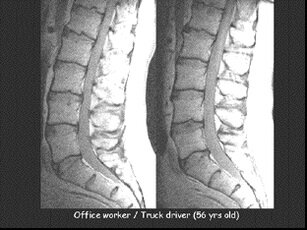“These study findings led us to the conclusion that lumbar disc degeneration may be explained primarily by genetic influences, early environmental exposures, and yet unidentified factors, which may include complex interactions, such as between environmental factors and individual spinal anthropometrics.”—Michele Crites-Battié, PhD.
“These study findings led us to the conclusion that lumbar disc degeneration may be explained primarily by genetic influences, early environmental exposures, and yet unidentified factors, which may include complex interactions, such as between environmental factors and individual spinal anthropometrics,” said lead researcher Michele Crites-Battié, PhD, of the University of Alberta’s Faculty of Rehabilitation Medicine.1Dr. Battié and colleagues received the 2008 Kappa Delta Elizabeth Winston Lanier Award from the American Academy of Orthopaedic Surgeons—arguably the most prestigious annual award in musculoskeletal research—for the manuscript summarizing their work, “The Foundation of a New Paradigm of Disk Degeneration: The Twin Spine Study.”1
The Twin Spine Study, an ongoing research program, was begun in 1991. It is a population-based study that includes 147 pairs of identical male twins and 153 pairs of fraternal male twins. Researchers from Canada, Finland, the United States, and the United Kingdom compared identical twin siblings who differed greatly in their exposure to a suspected risk factor for back problems. For example, one of the twins had a sedentary job while the other had heavy occupational physical demands, or one twin routinely engaged in occupational driving while the other did not. The studies yielded startling results, suggesting that genetics play a much larger role in disc degeneration than previously thought.
“In the past, the factors most commonly suspected of accelerating degenerative changes in the discs were various occupational physical loading conditions, such as handling of heavy materials, postural loading, and vehicular vibration,” said Dr. Battié.
Despite extraordinary differences between identical twin siblings in occupational and leisure-time physical loading conditions throughout adulthood, there were surprisingly few differences in disc degeneration [Figure 1]. The findings indicated that physical loading—handling heavy loads, bending, twisting, and static work in awkward postures—had only modest effect on disc degeneration.

High degrees of similarities in disc degeneration were noted between twin siblings, often despite high discordance in lifetime physical loading exposures. (In part from Spine, Battié et al 2004[55])
On the other hand, Dr. Battié said that during the exposure-discordant twin studies, “the striking observation of anyone who had the opportunity to view twin sibling images side-by-side was the strong resemblance in disc degeneration, not just in the degree of degeneration, but also in the types of findings and spinal levels involved. This led us to pursue studies of genetic influences.”
They discovered several susceptibility genes for disc degeneration, including 2 polymorphisms of the vitamin D receptor gene (Taql and Fokl). Other groups joined the research, and now 17 potential susceptibility genes have been associated with disc degeneration or associated pathology in at least 1 study. The most promising candidates are the VDR gene, COL9A2, and COL9A3, Dr. Battié said.
Translating research into practice
Dr. Battié told Musculoskeletal Report that clinicians should not be too quick to attribute degenerative disc findings to a back pain patient’s job or leisure activities. “The old injury model meant that, for example, in a person with a long-term history of working as a truck driver, disk degeneration would be seen as the result of whole-body vibration on the intervertebral disc. Our study suggests that this is likely an incorrect assumption.”
Reference
1. Battié MC, Videman T, Kaprio J, et al. The foundation of a new paradigm of disc degeneration: the Twin Spine Study. Paper presented at the 2008 AAOS meeting; March 4, 2008; San Francisco, Calif.






